FOA:
Looking Ahead to 2012
Many years ago, I
attended a class on forecasting. The lecturer started out
by saying that one should never forget that "all forecasts
are wrong!" Be that as it may, each year we still review
the past year’s happenings and then look ahead to the new
year. In fiber optics as with most technology areas, the
future is determined by a combination of technological
development, developing markets, the economic climate and
politics.
As we all know,
the world economic climate is unstable. However, because
of the rapid growth in Internet traffic, mainly video,
communications seems to be healthy in spite of the
economic uncertainty. Communications continues to build
out into sparsely served areas - Africa
is a major market right now - as well as expanding
service in areas already well-connected.
That means that
fiber optics, along with other communications
technologies, is growing. As usual, communications growth
is driven by both consumer and business use of the
Internet. Telecommunications
has become an obsolete word – voice traffic has been
surpassed by digital traffic for more than a decade now
and represents perhaps 0.1% of all communications traffic.
Furthermore, more than half that entertainment is viewed
on wireless devices, increasingly tablets, well, really
the iPad which represents the vast majority of tablets in
use.
What does this
mean for fiber? The future is bright. To bring more
capacity to the subscribers, FTTH continues to grow around
the world with more government mandated systems being
built as basic infrastructure. And wireless is not
wireless. Cellular backhaul has been increasingly moved to
fiber as smartphones – and now tablets – have overloaded
the wireless systems. AT&T reported that the iPhone
alone caused a 8000% increase (that's
80 times!) in data traffic on their wireless
system in the first 3.5 years after its introduction and
an iPad consumes a lot more bandwidth than any smartphone.
(Tablet
Markets)
Cellular systems
are not just using fiber for backhaul from the tower, but
the massive number of antennas sprouting on towers has
become too much for the big coax cables that traditionally
connected them. Fiber UP the tower to the antennas is now
becoming the norm.
WiFi is also
growing, not just for people with laptops in coffee shops,
but for carrying lots of traffic from smartphones which
can switch between the two networks. Super WiFi, using the
“white space” spectrum left when TV went digital, is now
in trial (the
first commercial hardware has been approved by FCC)
and could provide broadband to the suburban and rural
areas where fiber to the home is still not economical.
That means more fiber to the tower.
Wireless is also
impacting premises cabling. The old 1980s model of
premises cabling that led to structured cabling standards
is obsolete – why build a network with two copper cables
to the desktop when the user will have a cell phone and
wireless laptop or tablet that does not interface with the
wiring. Besides copper is ~$3.50 a pound and counterfeit
cables are everywhere causing problems. The new standard
for enterprise networks will probably be fiber backbone
and maybe straight to the wireless AP. Maybe energy
concerns will finally get users to consider that
alternatives are better than vintage copper cabling – see
http://www.cirrant.com/cirrantpdf1.pdf.
Speaking of
standards, the committees are locked in their usual
battles - “Cat 7” finally getting some attention, probably
a waste of time - and manufacturers arguing over the
compatibility of new technology.
This year will
also see more work in “smart grid” which depends on fiber
for communications also. Problems like the technician
flipping the wrong switch and putting 5 million Southern
Californians in the dark show the grid needs help.
Alternative energy, big solar and wind farms, use a lot of
fiber also and the plans for new builds are showing up in
many states.
For the FOA, we
continue growing in the US as more techs need fiber
training and more trainers realize that our premises
cabling certification represents the current reality –
copper, fiber and
wireless. Plus we now have recognition from the US
Department of Labor for our certifications (see below).
Overseas, we are being asked for our help in many
countries who are expanding their communications networks
and need advice, reliable technical information from our
Online Reference Guide and training from our FOA-Approved
schools and Certified Instructors.
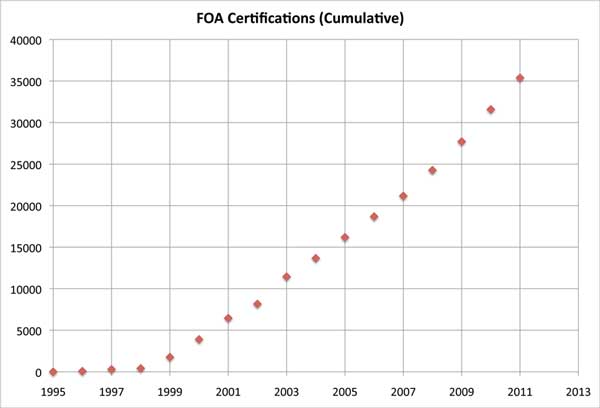
In 2012, the FOA
will continue expanding our technical reference materials,
online study programs, YouTube Videos and apps that allow
you to carry a full technical reference in your hand.
We’re even adding apps like the free “loss budget” app and
a "NECA/FOA-301 Standard" app for the iPhone/iPad that
assist designers and installers of fiber optic systems to
do their job easier. FOA and NECA have arranged to provide
this important standard to FOA members free and are
embarking on a new program to make standards available to
everyone. We are also focusing on issues that our members
say are important, for example, 2012 has been declared
"The Year of The OTDR" in the FOA. We have also decided to
write our own standards for fiber optic testing, but with
a new viewpoint - the "1 page standard". Read more below.
Jim Hayes, President, FOA
Update: Another good snapshot of the fiber optic
technology/industry is the paper "Optical
Communications in 2012" paper from the organizers of the OFC
conference to be held in LA in March.
Free For FOA Members: NECA/FOA 301 Fiber
Optic Installation Standard
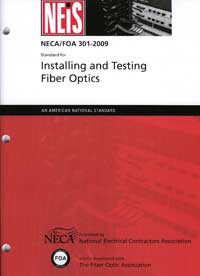
Because of its importance to users,
contractors and installers of fiber optic networks, The FOA and
NECA have agreed to make the NECA/FOA
301 Fiber Optic Installation Standard available free to
FOA members.
Standards usually cover components and systems and how to test
them, but rarely get into installation issues. This standard is
derived from FOA educational material put in standards form and
approved by ANSI as an American National Standard. It's
specifically written to be used in contracts to define
"installation in a neat and workmanlike manner." FOA
members can go here for instructions on how to download your
free copy.
FOA
1-Page Standards
Ever need a quick reference to a standard but can't find a copy?
Have you tried to read some of the documents and given up because
of the "standardese" language? Or have you ever tried to buy a
standard and just about fainted when you found our what it cost?
Well, we've heard all those complaints for years. And we're doing
something about it.
FOA is embarking on a new program to make standards more
accessible to the world of users, contractors, designers and
installers. We will start creating "One Page Standards" - simple
explanations of standards that you use all the time but don't need
the originals; you just need to understand how to use them. We'll
cut out all the fluff and give you the info you need.
But wait - can the FOA create standards? And what is a standard
anyway? Here is the definition by the world's biggest standards
organization:
ISO/IEC Guide 2:1996, definition
3.2 defines a standard as:
'A document established by
consensus and approved by a recognized body that provides for
common and repeated use, rules, guidelines or characteristics
for activities or their results, aimed at the achievement of the
optimum degree of order in a given context'.
Well, that certainly sounds like what the FOA is doing! As you all
know, FOA certification is now internationally accepted and our
technical references the first choice for unbiased, technically
correct information on fiber optics and premises cabling. It's
certainly logical that we would next try to put some order in the
chaos of current standards. FOA
standards are developed by FOA members whose expertise is in the
technical areas covered by the standards and whose experience in
the industry contributes to FOA standards being accurate,
relevant and current.
Look for the "1
PageStandard" web page and in the FOA Online Reference
Guide. Watch the FOA Newsletter for FOA Standards Apps.
Download the FOA 1Page Standards to your tablet or smartphone!
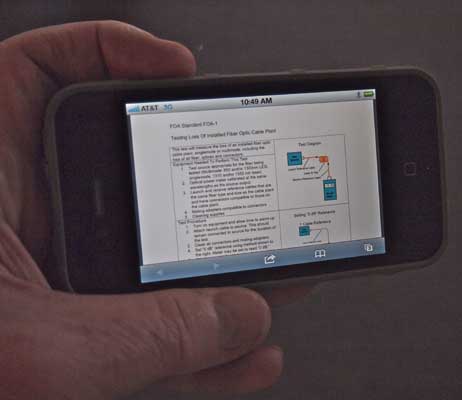
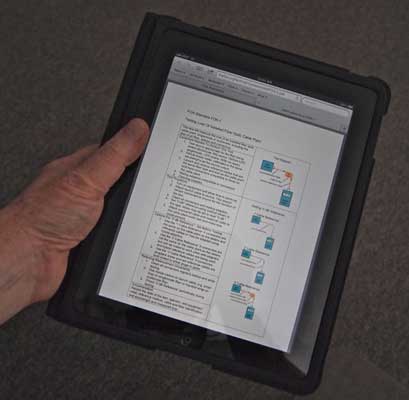
2012: The Year of The OTDR
Most of the technical and testing questions we get here at FOA
involve misunderstanding of OTDR testing. A number of FOA master
instructors have suggested we focus on OTDR training, both in our
schools and online, to minimize the problems, so we have declared
2012 "The Year of The OTDR." Look for special articles, a
new "1pStandard" and other information that will make these
instruments less enigmatic!
Start with the new Fiber U OTDR self study course, "Understanding
OTDRs". You can also download the Free
FOA OTDR Simulator to practice analyzing traces.
OTDR Tip Of The Month:
- Why Do I Need A Launch Cable On
The OTDR?
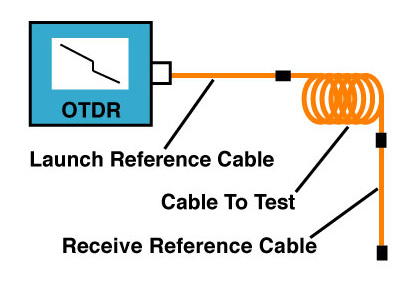
- OTDRs are always used with a launch cable and may use a
receive cable. The launch cable, sometimes also called a
"pulse suppressor," has two major reasons for its use:
- 1. The launch cable allows the OTDR trace to settle down
after the test pulse is sent into the fiber so you can analyze
the cable near the OTDR. The large event you see right in
front of the instrument on the OTDR trace is caused by
crosstalk within the instrument and reflectance from the
connector on the face of the OTDR. The long recovery time from
this overload pulse means the OTDR cannot make any useful
measurements near the instrument itself. The launch cable has
also been called a "pulse suppressor" because it allows time
for the OTDR to settle down from this initial overload. If
possible, singlemode OTDRs should have APC connectors on the
front panel to reduce reflectance. Also a short connection
cable attached to the OTDR before the launch cable that never
gets removed from the OTDR prevents excess wear on the panel
connector.
- 2, The launch cable provides a reference connector for
the first connector on the cable under test to determine its
loss. A receive cable may be used on the far end to allow
measurements of the connector on the end of the cable under
test also.
Why is there a reference cable at the far end? To let the OTDR
measure the loss and reflectance of the connector on the far end
of the cable under test.
FOA Certifications Recognized By US Department of Labor

All
FOA
Certifications have now been recognized by the US
Department of Labor. The DoL reviews certifications and
how they relate to job opportunities and training. The DoL
Career OneStop website helps individuals explore
career opportunities to make informed employment and
education choices. The Web site features user-friendly
occupation and industry information, salary data, career
videos, education resources, self-assessment tools,
career exploration assistance, and other resources that
support talent development in today's fast-paced global
marketplace.
FOA
Certifications Listed By US Department of Labor - Career OneStop
Fiber = Energy Savings In Premises Cabling
Fiber has always been a tough
sell in the premises cabling business where over a century of
copper wire has made its use as much a tradition as a technical
choice. But what happens when you analyze the energy use of a
centralized fiber network versus a traditional copper network? Cirrant
Partners, a NY IT infrastructure consulting and
engineering company has done just that and issued a report on
their findings. Here is how it starts:
"The total IT energy consumption
in the US in 2011 is estimated to be slightly more than 100
Billion kWh2. (This is based on the energy consumption being 80%
of the 2007 projection.) The actual consumption may be lowerdue
to the economic times. Energy costs vary per state and usage
classification and contract agreements. At a commercial national
average price of 10.77 cents per kWh,3 the total IT energy
consumption cost is estimatedto be $10.77 Billion. Annually,
Billions of kWh of IT energy go unmonitored and largely
unmanaged. A large part of the consumption is inefficiently-used
energy by local area networks and supporting infrastructure"
Free FOA iPad App Calculates Loss
Budget
The FOA has just released its second APP for the
iPad/iPhone/iPod Touch, a free "loss budget
calculator," FOA LossCalc.
FOA LossCalc
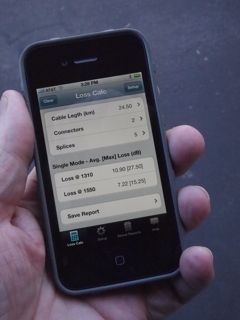
FOA LossCalc estimates the optical loss of a fiber optic
link. This will save time for the installer of a fiber optic
link needing to know whether test results are reasonable
and/or make a "pass/fail" determination. It can also help
the designer of a link to determine if communications
equipment will operate over this link.
By choosing the type of link (singlemode or
multimode) and specifying the length of the fiber and
numbers of connections and splices, it will calculate the
end to end loss of the link. The app has default
specifications for singlemode and multimode links or the
user may create custom setups with specifications
appropriate for any application.
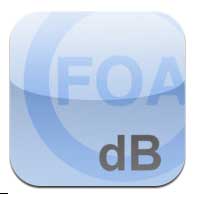 http://itunes.apple.com/us/app/foa-losscalc/id476262894?mt=8&ls=1
http://itunes.apple.com/us/app/foa-losscalc/id476262894?mt=8&ls=1
More Applications For Composite Cables
We have recently talked to several contractors
doing "fiber to the antenna" installations for cellular
towers. Some of their applications are using composite
cables - cables with both fibers and copper power conductors
in the same cable. This makes sense for cellular antennas
which need both power and signal and a composite cable can
be terminated in a factory, at least on the top end, and
easily installed.
Another similar application was brought to our attention by
a telco installer working on FTTC. He was installing new
boxes nearer subscribers and the cable he was running to
each box was a composite cable with 2 fibers to the box and
copper conductors for powering the box. Thus the
installation of the box was quite simple, plug and play for
both fiber and signal, and the cable was spliced into the
network at the other end.
Composite cables make lots of sense, even for premises work
where a single cable can both power and communicate with
many devices like CCTV cameras or wireless access points.
More New Lectures on 
New Lecture Series on Premises Cabling - 10
Lectures Posted Already
New Fiber Optic Lectures (25 Total Now) Covering
FTTx, Testing,
Total Internal Reflection, Modes, VFLs And That Old
Favorite "Fiber Or Copper" (With A New Twist: Wireless!)
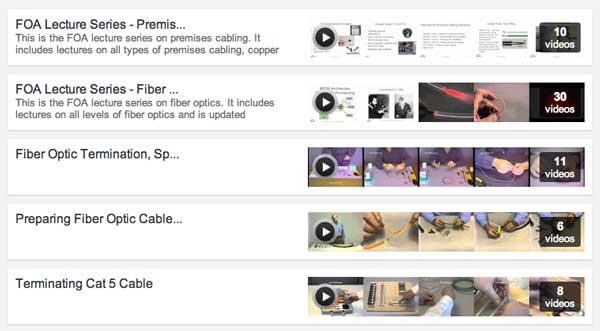
10 new lectures on premises cabling have been added to
the FOA YouTube channel along with a lecture on fiber to the
home - FTTx, making 25 fiber optic lectures total.
Below is a list of the current lectures
(plus there are 28 hands-on videos too!). We're looking for
ideas for topics for future lectures. Send your ideas to
<info@thefoa.org>.
Benchmarking Fusion Splicing And Selecting
Singlemode Fiber
We've been asked many times "How long
does it take to splice a cable?" It's not a simple answer as
it varies with the number of fibers in the cable and the
work setup, including whether one or two techs are working
at a job site. FOA Master Instructor Joe Botha of Triple
Play in South Africa did his own analysis based on decades
of experience both splicing cables and teaching others how
to do it properly. This is one of the best analyses we have
seen because Joe includes prep times as well as splicing
times and differentiates between one tech and two techs
working together. He adds some other tips on fusion splicing
too. This should be mandatory reading for every tech and
given to every student! Here
is Joe's splicing analysis.
Joe also has an excellent writeup on how to choose
singlemode fiber that helps understanding the different
types of G.6xx fiber. Read
it here.
Free - Mike
Holt's Explanation Of The US National Electrical Code
(NEC) For Communications Cables
Mike Holt is the acknowledged expert of the US
National Electrical Code (NEC). His books and seminars are
highly praised for their ability to make a very complicated
standard (that is in fact Code - law - in most areas of the
US) easily understood. Part of the appeal is Mike's great
drawings that make understanding so much easier. Mike makes
Chapter 8 of his book available free. It covers
communications cables, telephones, LANs, CATV and CCTV, for
premises applications. Even if you live in a region or
country where the NEC is not the law, you may find this
interesting.
Download
Mike's Chapter Here.
One Man's Opinion
Should competitors unite to provide broadband? Should utilities be
brought into the mix too? Should the united organization get tax
breaks for cooperating to get broadband to everybody? Steve
Rivkin, Washington Telecom Lawyer, has some interesting ideas on
this subject. Read
his article here.
Events of Interest

Technical Conference March 4-8, 2012 • Exposition
March 6-8, 2012
Los Angeles Convention Center, Los Angeles, CA, USA
OFC/NFOEC is the #1 fiber optic conference and show in the USA
if not the world, with more than 500 companies displaying the
cutting-edge products and technology that will define next
generation networks. The ONLY place you can see and meet with
all the major players in one location. Where is the optical
communications market going? Attend Market Watch sessions and
gain insight into the latest system and component drivers and
uptake, and roadmaps for this market. FREE Admission to the
exhibits and extensive business programming in three show floor
theaters.
More information.
A
good snapshot of the fiber optic technology/industry is the
paper "Optical
Communications in 2012"
paper from the organizers of the OFC conference.
AFL to Host "Traveling" Advanced Splicing Seminars
AFL has launched advanced splicing seminars intended for
engineers and professionals, as well as university students,
engaged in fiber optic activities involving non-standard and
specialty fusion splicing activities. Typical applications for
these advanced splicing needs are often in the Medical, Oil and
Gas, Fiber Lasers, Optical Manufacturing, and Aerospace markets.
These seminars will cover a wide range of applications and
solutions for difficult and challenging applications using
advanced fusion splicing platforms.
- Seminars will be held in around the US and
Canada.
- There is no charge for attending; however AFL will be
conducting pre-registration in order to ensure availability
of a proper facility depending upon the number of
attendees.
- Details on the seminar, a current schedule and signup
form are at http://www.stateofthearc.com/seminars/signup.html
Free Corning "See the Light" Seminars
Corning Cable Systems' See the Light team is coming to a city
near you! Receive Free fiber optic training on a variety
of topics including Termination Technology, Testing and Trouble
Shooting, Fusion Splicing, and Preterminated Solutions. These
interactive three-hour sessions provide students with a
comprehensive overview of the latest technology. Fiber optic
BICSI (CEC) credits apply (3).
Here
is the current information and schedule.
JDSU Testing Webinars
You are invited to join JDSU for a complimentary series of
educational webinars in early 2012. Each webinar, presented by a
JDSU subject matter expert, occurs on the same day and time of
the week and will last approximately one hour, including
Q&A.
Go
here to see the seminars offered and dates. IMPORTANT:
use registration password: FONA1.
Don't forget to download your copies
of the JDSU Testing Textbooks.
 What's
New @ FOA What's
New @ FOA
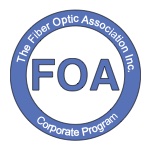 New
Corporate Memberships New
Corporate Memberships
FOA is now offering corporate memberships to companies
involved in fiber optics as manufacturers, contractors,
installers, etc. Read
more. Among other benefits, Corporate Membership gives
companies access to special FOA materials for educating
customers and employees.
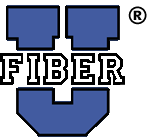
Two New Free Fiber U Self-Study
Programs on Outside Plant Fiber Optics and OTDRs
There are two new free online self-study
programs on Fiber
U. "Outside Plant Fiber Optics" uses the new
FOA textbook and online reference guide to OSP to help you learn
about OSP fiber networks. The "Understanding OTDRs"
self-study program will help you learn how to properly use these
complicated instruments and there is a free OTDR simulator you
can download to use for practice.
FOA Certification On Outside Plant Fiber Optics
The FOA CFospT outside plant certification focuses on
OSP fiber optic network design, installation and maintentance. A
CFospT certified tech must know the ways that fiber is used in
the OSP, how it is installed, tested and maintained. While a
CFOT might only have a basic knowlede of fusion splicing and
OTDR testing, for example, a CFospT will be knowledgeable and
skillful in those areas - and more. Reference materials for the
new CFospT are the printed textbook, the FOA
Reference Guide to Outside Plant Fiber Optics
(right) as well as eBooks from Amazon for the Kindle or Apple
for the iPad/iPod/iPhone and the OSP
reference section of the FOA Online Reference Guide which
now includes a self-study
guide to the CFospT exam.
More information on the FOA Outside
Plant Fiber Optic Technician (CFospT) certification.
- Reference Books for FOA
Certifications are now available on Kindle and
iPad/iPhone



We have created three new FOA books to be used in training for
FOA certifications and as reference books for contractors,
installers and end users of fiber optics. These books have
full curriculum support, including free curriculum materials
for teaching FOA certification courses. Because we are
self-publishing these books using more modern "publish on
demand" technology, they are easier to keep up to date, easier
to buy and much, MUCH cheaper!
All are now available in print and electronically in Kindle
and Apple iBook versions. The basic fiber optic book is also
available as a self-study program in an Apple APP for
iPad/iPhone/iPod.
Details on the new book each of the new books are at the book
pages linked to the photos above.
FOA iPad Apps
The FOA has just released its second APP for the iPad, a
free "loss budget calculator," FOA LossCalc.
FOA LossCalc
 FOA
LossCalc
estimates the optical loss of a fiber optic link. This will
save time for the installer of a fiber optic link needing to
know whether test results are reasonable and/or make a
"pass/fail" determination. It can also help the designer of
a link to determine if communications equipment will operate
over this link. FOA
LossCalc
estimates the optical loss of a fiber optic link. This will
save time for the installer of a fiber optic link needing to
know whether test results are reasonable and/or make a
"pass/fail" determination. It can also help the designer of
a link to determine if communications equipment will operate
over this link.
By choosing the type of link (singlemode or multimode) and
specifying the length of the fiber and numbers of
connections and splices, it will calculate the end to end
loss of the link. The app has default specifications for
singlemode and multimode links or the user may create custom
setups with specifications appropriate for any application.
http://itunes.apple.com/us/app/foa-losscalc/id476262894?mt=8&ls=1
Self -Study in Fiber Optics
 Our
first app is a self-study version of the FOA Reference Guide
to Fiber Optics. The FOA APP builds on the FOA basic fiber
optic textbook to create an interactive learning environment
that builds on the iBook electronic version of the book to
add a guide to use for self-study and real-time testing that
provides feedback on what you have learned and correct
answers to questions answered incorrectly. Our
first app is a self-study version of the FOA Reference Guide
to Fiber Optics. The FOA APP builds on the FOA basic fiber
optic textbook to create an interactive learning environment
that builds on the iBook electronic version of the book to
add a guide to use for self-study and real-time testing that
provides feedback on what you have learned and correct
answers to questions answered incorrectly.
The FOA APP is priced at only $9.99, same as the iBook, so
the self-study program is free. Download it from the Apple
APP Store with your iPad or iTunes.
http://itunes.apple.com/us/app/foa-guide/id434354283?mt=8&ign-mpt=uo%3D4
NECA/FOA 301
Installation Updated

Standards cover components and systems and how to
test them, but rarely get into installation issues. The FOA NECA
301 standard which covers installation of optical fiber systems
has been revised for the second time, adding considerable new
materials. This standard is derived from FOA educational
material put in standards form and approved by ANSI as an
American National Standard. It's specifically written to be used
in contracts to define "installation in a neat and
workmanlike manner." The standard is available from NECA.

New Lectures: 25 Fiber Optic Lectures, 10
Premises Cabling Lectures Plus 28 More Hands-On Videos
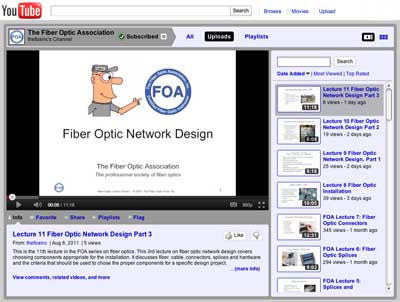
Below is a list of the current lectures (plus there are
28 hands-on videos too!). We're looking for ideas for topics for
future lectures. Send your ideas to <info@thefoa.org>.
New: Ten More YouTube Videos – Lectures On Premises Cabling
The FOA has added 10 more videos to our YouTube Channel,
thefoainc. These are an introduction to premises cabling,
covering applications, types of cabling, standards and
installation practices for copper (UTP and coax), fiber and
wireless. Like our lecture series on fiber optics, these provide
a comprehensive introduction to the subject in short videos,
typically 5-10 minutes in length, on each subject. Watch for
more.
Here is a list of the Lectures now on YouTube.
View
the FOA YouTube video Lectures.
What's New
in the FOA Online Fiber Optic Reference Guide
We have been updating
the Online Reference Guide to keep up with changes in the
industry and adding lots of new pages of technical
information.
OTDR FAQs
Including FOA Master Instructor Terry O'Malley's tests
on what the end of a fiber trace looks like with broken
and cleaved fibers.
Frequently
Asked Questions On OTDRS And Hints On Their Use
Testing FTTH
Basic
guidelines for testing FTTH PON networks
Measuring Reflectance or Return Loss
It
can be important but it's not so easy to test.
Frequently Asked Questions About OTDRs
When
do you use them, how to find distance to fault, what
effect does end preparation have on traces, more.
Encircled Flux
What
does this new method of measuring mode power
distribution in MM fiber mean to testing standards?
Fiber Optic and Premises Cabling Project Paperwork
Covering
what are SOW, RFPs and RFQs and how they are created
for a project.
Effects of Alignment and Fiber Geometry on Fiber Optic
Connector Loss
With
all the controversy about connector loss due to modal
distribution, we sometimes forget the effects of
component variations.
Fiber Optics For Wireless Networks
How
wireless is not wireless - it needs fiber.
Premises Cabling Installation
Installing
copper/fiber/wireless for premises networks.
Web Page on Bend Insensitive Fiber
Bend-insensitive
fiber is a "hot
topic" now - we try to explain how it works and what it
means for installation and test.
Basic Fiber Design Section Updated
Lots
of new materials added to this introduction
to fiber optic network design.
Web Page
on Data Centers
Data centers are the heart of the Internet,
storing and supplying data for user requests. Needless to
say, high performance cabling is needed to move the data
between storage, servers and routers. We've created a new
pagein our Online Reference Guide on data
centers - how fiber and cabling are vital to
their performance.
Learn More About OTDRs - Download
a Free OTDR Simulator
More and more installers are being asked for OTDR testing but
using these instruments is not easy. They are hard to set up
properly and complicated to interpret the traces. Using the
autotest function can lead to disastrous results! The FOA has a
good tutorial on OTDRs on our Online Reference Guide and we
added a free download of an OTDR
simulator to the OTDR
section so you can learn how to use an OTDR on your PC.
More New Info:
Links to manufacturers
and distributors of fiber optic lighting products.
The
FOA Online Fiber Optic Reference Guide
has become very popular - perhaps the most popular technical
website ever, typically with over 360,000 users downloading
about 1.75 million pages in 2011! We continue updating
materials regularly, keeping it as up to date as possible.
Find What You Want Using "Google
Custom Search
 There's
so
much information on the FOA Tech Topics and
Online Fiber Optic Reference Guide that even a
well-organized Table of Contents isn't enough and when the
material is always changing, an index is impossible to maintain.
So the FOA is using the latest technology in search, Google
Custom Search, which will allow you to search just the
FOA Tech Topics and Online Fiber
Optic Reference Guide for any topic you want to find more
about. Try
it! There's
so
much information on the FOA Tech Topics and
Online Fiber Optic Reference Guide that even a
well-organized Table of Contents isn't enough and when the
material is always changing, an index is impossible to maintain.
So the FOA is using the latest technology in search, Google
Custom Search, which will allow you to search just the
FOA Tech Topics and Online Fiber
Optic Reference Guide for any topic you want to find more
about. Try
it!
Go
to
The
FOA Online Fiber Optic Reference Guide.
School News
New Schools
The FOA welcomes the newest additions to our listing of
FOA-Approved
Training Organizations:
#325- The Urban League of the Central Carolinas
#636- IBEW Local 117
Find
a listing of all the FOA-Approved schools here.
It's
Now A Lot Easier To Find A FOA-Approved Training
Organization
Most phone
calls we get regarding finding a FOA-Approved training
organization want to know two things: what school is closest
to me or what school offers the certifications I need. That
can be difficult, since the FOA has almost 200 training
organizations we have approved worldwide!
We've been looking at ways to make it easier, and we think
we've got a good solution. In fact we have two solutions.
First we have added a sortable
table of all the FOA-Approved schools.
You can also use our FOA
Google Map Application to find FOA-Approved schools.
Here are links to the sortable
table of all the FOA-Approved schools and
FOA
Google Map.
What Should A Fiber Optics
or Cabling Tech Know and What Skills Do They Need?
The FOA has been updating its lists of KSAs
(Knowledge, Skills, Abilities) for fiber and cabling
techs. The updated list is now on the website for your
information and comments - as fiber and cabling KSAs
evolve as new technologies develop.
KSAs for fiber
and cabling techs.
Good
Question!
Tech Questions/Comments Worth Repeating
Tech Hint: Did
You Know You Have A Fiber Optic Tester In Your Pocket?
Yes! The camera in your cell phone is sensitive
to infrared light - lots more than your eye - and can
detect light in an optical fiber or from a
transmitter. Chris Hillyer,CFOT/CFOS/I,
Master
Instructor, Northern California Sound &
Communication JATC sent us some photos showing how this
works. See
below or the video
now on YouTube.
Higher Loss At Long
Wavelengths? 1/12
Q: I have a tech
in the field that has installed a piece of single mode
fiber approx. 650’ long. He is testing it with a source
and meter. The fiber is passing the 1310 loss test but
failing the 1550 test. What could be causing this? He
has put new ends on the fiber already and is getting the
same results.
A: This sounds
like a classic problem of cable stress. Singlemode fiber
is much more sensitive to bending stress losses at
1550nm than 1310nm. If there is a stressed area in the
cable installation, it's easy to get >3dB loss from a
tight bend or kink, even near the connectors. There
should be no difference with the connectors themselves.
Telcos test links at 1625nm for stress testing.
Followup: The
tech went back to the job site with an OTDR and found
there was a spike in the reading about 120’ from one end
which is where there is a pull box up in the ceiling.
Which
Adhesive For Termination? 12/11
Q: Epoxy, Hotmelt, and Anerobic
Adhesives - why each is used in in what
situations.
A: Epoxy/polish are used where highest yield,
lowest cost and max reliability are needed. They are
used for all factory made patchcords and a reasonable
percentage of field terminations. The downside is they
require an oven to cure the epoxy quickly. I actually
invented a AC/battery-powered oven for use in the field
that is still available -
http://www.afsi.us/product.php?product=CURING to
simplify the field use of epoxy.
Anaerobic adhesive is used when you are looking for low
cost and fast field termination. You can use it with an
"accelerator" solution that gives practically an instant
set to the adhesive but with some loss of
strength/reliability. We developed a method with no
accelerator that the Navy uses because it's more
reliable. The big difference with epoxy is the cured
adhesive does not have a drop (epoxy bead) on the end of
the ferrule that makes polishing virtually foolproof.
HotMelt (a 3M product) has the adhesive already inserted
in the connector, so you just heat the connector up,
take it out of the oven and insert the fiber. As soon as
it cools, it's ready to polish. It has the adhesive bead
on the end of the ferrule so polishing is easy. Against
it is cost ($5/conn vs $1/conn for epoxy and anaerobic
connectors) with essentially the same labor cost, a very
hot oven (twice as hot as epoxy) and the need for AC
power on site.
Some years ago, we did a study of termination times and
here are the results: http://www.thefoa.org/tech/ref/termination/TerminationTimes.pdf
More
On "Encircled Flux" - Maybe The Mandrel Wrap is "Good
Enough" 12/11
IEC 86C/1004/DTR is our for comments and due to be
be voted on next Spring, which by standards time is pretty
quick! Here is the official description:
"IEC/TR 61282-11 Ed. 1.0 Fibre optic communication system
design guides - Part 11: Multimode launch conditions
This technical report is intended to show the background of
encircled flux for the characterisation of multimode launch
conditions. This includes the selection of the encircled flux
and the definition of the encircled flux requirements in
conjunction with the implied variation in attenuation
measurements."
Lines 490-492 from the draft document say it matches VCSEL
launch conditions considered in 10 GbE. Lines 493-395 say it is
close to the mandrel wrap mode conditioner used in TIA standards
for many years.
That is a very useful conclusion.
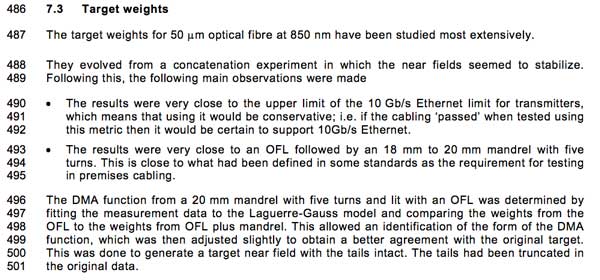
That's Why They Call Them "Dust Caps"
Q: We clean a connector, inspect it to ensure it
is clean then put the dust cap on. If we inspect it
after we remove that dust cap, it's dusty again, we
assume from dust in the cap. I have tested different
types and makes of dustcaps for the LC and clean ones
are rare. If you only push them on half way it
helps.....sometimes, but not always. Does any
company make clean (guaranteed) ones?
A: I've been saying for years that the reason
they call them "dust caps" is they contain lots of dust.
I know of no clean ones. Think about how they are made
in millions and dumped in big bins in a factory! You
just have to clean connectors when you remove them. Have
you tried some of the dry cleaners? They seem to work
well.
Fiber
Cleaning
This is a topic we keep reminding everybody about, and
here is why:
From a contrator in the Middle East:
Here some samples of the connectors for SM fiber already
installed in the system we were testing.
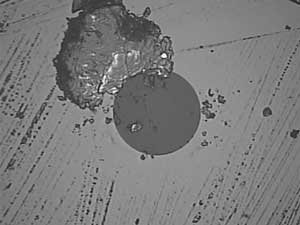
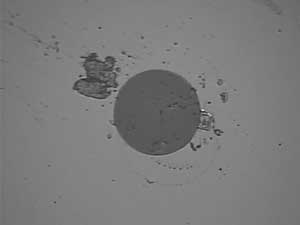
As you can see, the dirt is
large compared to the size of the fiber (dark gray), and the
core (not visible here) is only 9/125 of the overall
diameter of the fiber! More
on cleaning. See Product
News below for links to vendors of fiber cleaning products.
See news about Fiber
Optic Cleaning Videos on YouTube by ITW
Chemtronics below.
Measurement Uncertainty: Everyone testing
fiber optics should understand that every
measurement has some uncertainty - whether you are
measuring loss, length, wavelength, power, etc. Knowing
that uncertainty is very important to
interpreting the measurement. It's worthwhile to
read and understand the issue of measurement
accuracy covered in this
page of the FOA Online Fiber Optic Reference
Guide.
Worth
Reading
or Watching:
The FOA Visits To New Zealand,
Australia and Malaysia
You
can download the FOA PowerPoint presentation and view it
here:
What's New in Fiber Optics: http://www.thefoa.org/ZIP/FO2011.zip
FOA President Speaks At NZ "Rural Broadband
Symposium"
You can download the FOA
PowerPoint presentation and view it here:
Rural Broadband In A Changing World: http://www.thefoa.org/ZIP/TUANZ.zip
More
photos from the FOA trip here.
New Eric Pearson Books


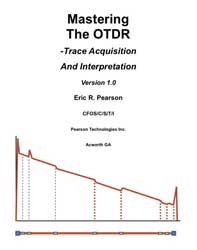
Pearson
Technologies Inc. announces the release of three new books,
Professional Fiber Optic Installation, The Essentials For
Success, Mastering Fiber Optic Connector
Installation and Mastering The OTDR.
Based on 31 years of experience, laboratory testing,
development, and training of more than 8000 installers,
these books is suitable for training, installation,
personnel certification, and reference. Eric's books are
perhaps best described as fiber optic "cookbooks," full of
detailed directions that reflect many years of tesing in his
courses. They are valuable references for the fiber optic
tech.
For additional information. contact Pearson Technologies
Inc., www.ptnowire.com,
fiberguru@ptnowire.com,
770-490-9991
Fiber Optic Cleaning Videos on YouTube
ITW
Chemtronics has three fiber optic cleaning videos
on  covering Dry
Cleaning, Wet-Dry
Method, FiberWash
and Combination
Cleaning. They are good explanations of cleaning
processes - the Wet-Dry is especially interesting.
covering Dry
Cleaning, Wet-Dry
Method, FiberWash
and Combination
Cleaning. They are good explanations of cleaning
processes - the Wet-Dry is especially interesting.
Should You Use Dry Water-Blocked
Cables Near Salt Water?
Here's another controversy in the fiber optic business. It seems
that some dry water-blocked cables have problems with salt water
affecting the speed and amount of water absorption by the super
absorbent powder (SAP seems to be a new industry TLA - that's
"three letter acronym" - for super absorbent powder) used in
these dry water-blocked cables (DWB?). It seems that salt water
performance has caused some users to not use this cable anywhere
that it may encounter salt water. But according to an article by
Ryan Chappell of Coats, a manufacturer of the yarns used in
fiber optic cable manufacture as well as SAP, there are big
differences between the absorbency of materials from different
suppliers. We suggest you 1) read
the article in Lightwave, 2) check
out the Coats website and 3) ask your fiber optic cable
manufacturer about their cable before installing it in a
salt-water environment.
We're Part of A
$trillion Industry in the US
A TIA commissioned report on “The Contributions of
Information and Communication Technologies to American
Growth, Productivity, Jobs and Prosperity,” (written by
Robert J. Shapiro and Aparna Mathur, August 2011) finds that
“ICT companies accounted for 3,535,000 jobs in 2009.” The
report states that “in 2009, ICT firms contributed about $1
trillion to U.S. GDP, or 7.1 percent of GDP. This
total includes nearly $600 billion in direct contributions
from their own operations and more than $400 billion in
indirect contributions through the benefits other sectors
derived from the use of ICT.”
Other highlights from the report include:
“The President’s proposal to fund the development and
initial deployment of a nationwide wireless broadband data
and communications network for public safety agencies would
lead to the creation of an estimated 100,000 new jobs in ICT
industries and, over time, produce indirect or spillover
benefits of an estimated $4 billion to $8 billion per year.”
“Investments of $3.4 billion in a “Smart Electricity Grid”
under the 2009 Recovery Act should directly produce nearly
30,000 new jobs. If the funding becomes seed money and
an ICT-based Smart Grid is developed and deployed, analysts
estimate the net economic benefits could range from $48
billion to $76 billion per year.”
From the TIA PR. You can download the entire report at TIAonline.
Wire & Cable Asia
A new newsletter about the wire and cable (and fiber
optic) industry in Asia is available online. See http://www.read-wca.com/
for more information.
Fiber Optics In WindPower
Fiber is an important communications tool for wind farms. In
this webinar, you will learn some of the driving forces behind
the evolution of wind power systems as well as the design
challenges, specifically in the area of data communications.
Solutions for high-reliability communications links using
optical fiber technology will be presented. These solutions
offer the galvanic isolation and electrical noise immunity
required to address wind power system needs. Avago Technologies
products meeting the needs of wind power system designers will
be profiled.
Download
it for viewing.
IGI Consulting Plans New Series of Government Telecom, Fiber
Optics and ICT Marketing Guides
IGI Consulting has initiated a project to develop a series of
ten Marketing Guides to assist companies in accessing the
military and government telecommunications, fiber optics, and
information technologies markets. The government represents a
major large and stable market. Despite pressure to reduce the
government budget, there will still be a need for government to
use technology to improve productivity and provide services and
security. IGI Consulting has analyzed all the major government
agencies responsible for buying, specifying, and investing in
telecommunications, fiber optics, and information technologies.
This provides the marketing manager with an independent view of
the government market and saves time searching the web for the
information. Here are the ten volumes:
More
Information.
Corning Has Translated Training Documents and Videos Into
Spanish
Check with Corning for availability.
Smart Grid
The National Association of
Electrical Distributors has created a nice overview of
"smart grid." It covers a brief overview of the US electric
power system, an understanding of why the smart grid has
become a national priority, a snapshot of the various
electrical components and concepts that are part of the
smart grid, advice on how your business can get involved and
a look at some key players who should be on your radar if
they aren't already.
Go to the NAEC
Smart Grid website and download their Quick
Start Guide.
A Documentary Treasure on the
History of the Internet
15 minutes of a rarely-seen
BBC documentary demolish the myth that ARPAnet was inspired
by nuclear war, and explain the far more intriguing truth.
http://www.technologyreview.com/blog/mimssbits/26719/?nlid=4433
Searchable IGI Publication Archives
Now Available as Google eBooks
Information Gatekeepers Inc.
(IGI), a leading international supplier of information on
fiber optics and telecommunications markets and technology,
has entered into an arrangement with Google to make its
archives available as Google eBook.
Since 1977, IGI has been publishing newsletters, conference
proceedings, market research reports, and other publications
focused on worldwide markets in telecommunications and fiber
optics. With Google eBooks , all of these publications and
studies — including previously unavailable earlier works —
are now available in searchable, electronic format to market
researchers, financial analysts, lawyers, governments,
university researchers, libraries, and all other interested
parties. Please search our new archive by visiting
igigroup.com or entering search terms in the box below.
The new Google eBooks of IGI publications are also the best
available for reading on mobile devices. Google eBooks can
be read on the Web, Android phones, iPhone, iPad, iPod
touch, and supported eReaders. Learn more about our
supported devices.
For more information on the new Google eBooks of IGI
publications please visit igigroup.com.
You can search Google Books for IGI publications directly -
Go
here.
Ensuring Distance Accuracy On OTDR Measurements
By
JDSU.
Broadband Properties Webinar
Archives

Lots of interesting webinars, mostly on FTTH. Go
here.
FTTX Networks
An ADC white paper on how they
work and how networks are upgraded to FTTH. http://connectedplanetonline.com/images/CP-ADC3-WhitePaper-v4.pdf.
JDSU Application Note On "Qualifying
FTTH Network before Equipment Installation"
Another great paper from JDSU covering FTTH PON
networks is available for downloading. It gives an overview of
FTTH architecture, cleaning connectors then testing the cable
plant with OTDRs and OLTSs. This paper will help you understand
why OTDRs can be confusing on PONs!
Best Practices For Wireless Backhaul Network Upgrades
Joan Engebretson, Contributing Editor of Connected Planet has
written a very good overview of how fiber is essential to the
operation of cellular wireless systems. Everybody probably knows
that fiber is used to connect towers into the telecom network -
they call it backhaul - but her article also covers the new
appliations to replace bulky, heavy, lossy coax up the
tower to the antennas. http://connectedplanetonline.com/images/CP_ADC2_WhitePaper.pdf.
Fiber
Optic Safety Poster
We've had numerous requests to reprint our guidelines
on
safety when working with fiber optics, so we have created
a "Safety Poster" for you to print and post in your classroom,
worksite, etc. We suggest giving a copy to every student and
installer.
Corning now offers videos on  .
Lots of interesting videos, some technical, some sales, but all
good information. .
Lots of interesting videos, some technical, some sales, but all
good information.
US Conec's videos
on cleaning fibers - show's the results of
proper cleaning.
Webinars of Interest
Broadcast Engineering Magazine - Fiber Optic
Testing
FOA President Jim Hayes presents an overview of
fiber optic testing for all applications. Available on
Demand. Sign
up here.
Multimode Fiber Trends from
TIA's Fiber Optics LAN Section
Ryan Chappell, Draka Communications, looks at the evolution of
multimode fiber, examines its current usage and shares
predictionson its future Available on-demand at: http://www.brighttalk.com/webcast/7182/play
OSP Magazine Webinars
OSP Magazine (OSP as in outside plant telco) is now offering
a number of interesting webinars that cover fiber topics,
including network design and specialized components. http://www.ospmag.com/events/web/
Multimode
Fiber Characterization Launch Condition Considerations - new
ap note from JDSU
JDSU Reference Guide to Fiber Optic
Testing – Volume 2 Published
The second volume of the JDSU series on fiber optic testing has
been published. Volume 1 focused on Basic Fiber
testing and Volume 2 is geared toward fiber optic installers,
project managers, telecom technicians and engineers who need to
understand fiber networks. Volume 2 also covers Chromatic
Dispersion, Polarization Mode Dispersion, Attenuation Profile
and Fiber Link and Network Characterization. A 3rd volume, a
glossary of fiber optic terms, is also available for download.
This is a "MUST HAVE" for all fiber optic techs. Download
your free copies here.
We used this book as one of our references in creating a new
page
in the FOA Online Reference Guide on chromatic dispersion (CD)
and polarization-mode dispersion (PMD).
Careers
in Fiber Optics: Brian
Smith.
A 1998 book on fiber optic jobs is a bit dated, but a free
overview is on Google Books and worth a look at it online.
Dirt!
As much as 70% of the problems associated with
deploying fiber to the home result from something as simple as
dirty connectors according to JDSU. Telephony
Online.
US Conec's videos
on cleaning fibers - show's the results of proper
cleaning.
Good Technical Websites
American Polywater (http://www.polywater.com/)
has one of the best technical website for cable installers. Here
is a rundown on some new material on their site.
Cable Installation using "Push" or "Push/Pull"
Polywater's new Pull-Planner™ 3000 Software allows a "pushing
force" variable in pulling tension calculations. Read a
White Paper that quantifies the push contribution and compares
calculation results to field experience. --
http://www.polywater.com/pushing.pdf
Pulling Cable Through Water?
Read a Product Spotlight on Polywater® + Silicone™, Polywater's
new generation underground lubricant. Continued reduction
of friction when pulling through water is only one of the unique
features of this lubricant. --
http://www.polywater.com/NNNBSL.pdf
Check out their website, especially “Videos,” “Engineer’s
Corner” and “Calculators.” http://www.polywater.com/NNNBSL.pdf

" Heard on the Street" is a monthly online newsletter from Frank
Bisbee of Communications Planning Corporation that covers
the telecommunications and cabling businesses. Each month
includes news from manufacturers, trade associations and
professional societies like the FOA. You can read the current
issue and back issues online.

JDSU has announced the See the Light
webinar series, a four-part program designed for anyone
involved in the installation, maintenance, and repair of
fiber optic systems. It begins with fiber inspection and
cleaning and then covers the basics of fiber testing. The
webinar series then continues with the more advanced optical
time-domain reflectometer (OTDR) and fiber local area
network (LAN) testing challenges. More
information on the series.
IGI is offering a series of webinars on topics of
interest to those in the communications industry. You
can join them live ir download from the archives. IGI
WEBINAR ARCHIVES UP AND RUNNING - VISIT TELECOMBRIEFINGS.COM
TO DOWNLOAD!
IGI, a major market research and technology reporting
company (the "Active Optical Cables" below) is
offering a a free one year subscription to one of our
fiber optics newsletters to FOA members. All
they have to do is to send IGI an e-mail stating which
newsletter they would like to get. See http://www.igigroup.com/nl.html
for a listing of IGI Newsletters.
-
- FOA
Tech Topics -
A Fiber Optic Tester In
Your Pocket? (See the video on  )
)
Yes! The camera in
your cell phone is sensitive to infrared light - lots
more than your eye - and can detect light in an optical
fiber or from a transmitter. Chris Hillyer,CFOT/CFOS/I,
Master
Instructor, Northern California Sound &
Communication JATC sent us some photos showing how this
works and the following description.

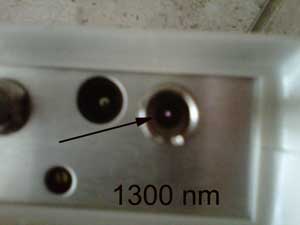
"Your cell phone camera's
image sensor can read IR light. It uses this technology to help
take pictures at night.
In the advanced audio and CCTV field they have been using the
smart phone camera to trouble shoot problems in IR
communications. The human eye cannot see the IR light emitted by
let’s say a remote control. Well up until now we would
always say that the remote is out of batteries, or either the IR
transmitter or IR receiver was not working properly. Now we can
use your smart phone camera to see the IR light emitted by the
IR transmitter. All you have to do is turn on your camera
function on your smart phone and hold it up the remote control
and push any button. The cameras screen will show the IR light.
Now back to Fiber Optics. If you follow the same principals of
the last paragraph, let’s say you wanted to check if a fiber
port was energized. You can either use the card that is supposed
to show you in a few seconds that the port was hot. Or you could
plug in your meter, in this case it takes some time to find the
card or if you don’t have your meter handy. Just pull out
your smart phone turn on the camera and hold it over the port.
If it is hot you will see a bluish white dot in the fiber bulk
head (see attached pictures)."
We tried this ourselves and found our camera phone very
sensitive at 850 nm but as expected less so at 1300 nm, like all
semiconductor detectors. Our phone could still see 1300 nm
sources at around -20 dBm, making it very useful even for LED
sources, and of course, perfect for lasers.
- FOA
Technical Bulletins
- How do you design and manufacture
fiber optic systems? Choose and install one to serve your
communications needs? Troubleshoot problems? The FOA Fiber
Optic Technical Bulletins will provide step-by-step
guidelines to help you. All are PDF files you can
download, print and use.
- Testing
Update
- Are there really 5
different ways to test optical fiber cabling after
installation? Why so many? How do the measurements - and
more importantly the measurement results - differ? What are
the advanteages and disadvantages of each method?
- Why
are there 4 ways (maybe 5) to test fiber optic cables?
- Do
OTDRs and OLTS tests give the same results?
-
- New Tech
Topics
- Industry
standards updated to include international standards
- Updated link
specs for fiber optic networks - now includes
10/40/100G Ethernet.
Product
News
Handheld OTDR
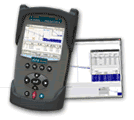
Advanced
Fiber
Solutions has introduced a new compact portable OTDR
that offers high resolution (to 1m) and light weight
(1.6 pounds, 0.72 kg) plus numerous wavelength and
range options. Here
is more information.
Protecting Pedestals From Rodents
Pedestals
and
underground vaults can be damaged by rodents who come
up through the base and damage cables. Uraseal "Drain
N'Seal" foam deters mice from taking up residence in
your pedestals. They
have some good videos on using their product.
A Cable Tie That's Fiber Friendly
We're always
warning installers not to tighten cable ties too tightly
around fiber optic cable (or UTP copper cable either!) A
better choice is the hook and loop fastener ties (Velcro
is one trade name), but there is another type, the
Mille-Tie. It's an open tie that can be used at any
length, then cut off and the remainder used also. Take a
look a the video to see how it works.
Mille-Tie Video: http://www.youtube.com/watch?v=QPVTQGKmcvE
Used Test
Equipment – Buy or Sell
http://www.testequipmentconnection.com/
Have you read the FOA
Tech
Topics on Cleaning?
More links on cleaning:
Westover
- AFL
ITW
Chemtronics
Cleantex
Alco Pads
MicroCare
Seiko-Giken
-
- FTTH
Notes:
Testing FTTH
JDSU shows how to test a PON with an OTDR: http://www.jdsu.com/other-literature/PON-OTDR_fop_an_ae.pdf
-
- Want To
Learn More About FTTx?
- The FOA has created a
special FTTx
resources section of our website with a FTTx
links page with lots of links to news, market reports,
technical articles and vendor technical and product
information. Here
is a great place to start learning more about FTTx.
- FOA's
CFxT FTTx Certification Program Explained
- Read
the Broadband Properties article about the FOA FTTx
certification program. Read
the
article about FOA President Jim Hayes being honored for
his work promoting FTTH.
-
|
-
Employment
New FOA Jobs Website
We get many questions from
CFOTs, students at FOA-Approved schools and others
contemplating getting into the fiber optic business regarding
jobs in fiber optics - and how
to
find them - so we’ve
created a new web page to share some information we've gathered
about jobs in our industry. The information is designed to help
you understand what jobs are available in fiber optics, how to
find them and apply for them.
While the overall economy is pretty bad - you've probably heard
that there are 5 times as many people unemployed in the US as
there are jobs available, telecom is a bright spot - broadband
is a major focus of stimulus spending in the US and countries
around the world are building fiber networks as fast as
possible. Even wireless companies have to build fiber for their
backhaul. Cities are installing fiber linked surveillance
cameras and smart traffic lights. Fiber is the link making Smart
Grid possible. Companies like Allied Fiber are building large
private networks. Telecom is one of the fastest growing
businesses worldwide.
If you
are looking for a job in fiber optics, here is the
FOA's guide to jobs.
The FOA has created a group on  expressly
to help our CFOTs find employment and contracting
opportunities. If you are a CFOT and are interested in
participating, join us on
expressly
to help our CFOTs find employment and contracting
opportunities. If you are a CFOT and are interested in
participating, join us on  .
If you have job openings, let us post them on .
If you have job openings, let us post them on  . .
A
list of 10 ways to get your resume noticed from
Marketplace on NPR
Jobs Created As Part
of Stimulus-Funded Projects
The federal government is spending 7.2 billion dollars on the
Broadband Technology Opportunities Program. This money is
working it's way into the economy and hopefully will provide
jobs. You can track recovery dollars and look for job
opportunities on this website: www.recovery.gov
Go
to "opportinities" link then "jobs". You will see a
section “find recovery jobs” – enter “fiber optic jobs
California” or wherever you are and review what comes up.
One of the projects funded by stimulus money is the 1100
mile network of Maine
Fiber Company Inc. which has selected nextGen
Telecom Services Group Inc. as the installation
contractor. CFOTs:
NextGen has a link on their website for applying for
jobs
Job
Openings
Fiber Optics Engineer/Technician (Feb 2012)
Are you crazy about new technology and how the
communications space is changing to meet the expanding
bandwidth requirements in the communication age? Have you
spent five plus years in the field working directly with
fiber and service providers and want to move into a
product development role that solves problems up front? If
working with a dynamic team and some of North America’s
top triple play service providers is a direction you want
to take your career, please email a covering letter
stating your experience and your resume to dhammersley@vplenterprises.com.
A little About Us:
Primex Telecom is a division of VPL Enterprises Ltd, a
plastic injection-molding company that specializes in the
manufacture and distribution of telecommunication and
building products. Primex specializes in developing,
producing and distributing flexible enclosure solutions
for the cable and
telecom industries. We offer turn-key and OEM solutions
for CATv, Copper and Fiber termination boxes in a series
of off-the-shelf products as well as ready-to-install
customized enclosures. At Primex, we makeeverything fit –
so you don’t have to.
Description:
You will work collaboratively with internal teams and
customers to build on product offerings using existing
ideas, and will use your industry experience to prioritize
and develop new features and designs. You possess a unique
blend of business and technical acumen and have the
ability to see the ‘big’ picture. You have the
determination to make the company’s vision a reality and
enjoy spending time in the market to understand customer
issues and develop innovative solutions.
General Duties and Responsibilities:
To work in close collaboration with Telecom sales,
engineering, customers and prospective clients to design
and build market ready optical fiber, copper, wireless and
OEM network termination, demarcationand connection
enclosures. Assist in strategically sourcing specified
components and alternates and follow through to completion
all relevant certification processes and requirements for
the Telecommarketplace. The Fiber Optics
Engineer/Technician is the technical sales support
resource responsible for working with front line sales
teams, marketing, customers and engineering teams to
conceptualize,design and execute the development and
market acceptance of Primex solutions.
Responsibilities: Capturing detailed requirements and
ensuring that our internal mechanical engineering team
understands all requirements & develop products that
are consistent with our brand and appropriate for the
marketplace.
Direct relationship management with external customer
engineering teams to develop solution- focused products.
Building and maintaining business relationships with any
partners and suppliers necessary to ensure the success of
the products, including vendor selection.
Research and analyze customer design proposals,
specifications and other data to evaluate the feasibility,
cost, and maintenance requirements of designs or
applications.
Assess customer network specifications and assist in
procuring specified components and work towards value
engineering part substitutions where possible to increase
value.
Specify system components or direct
modification of products to ensure conformance
with engineering design and performance
specifications.
Perform research and report on competitive
products; assist Marketing and Sales with
developing differentiating product positioning
strategies.
Provide technical customer service in
coordination with Sales as required.
Train internal staff on market trends, new
technologies and specifically the expanding role
of fiber optics in the communications space.
Required Skills and Qualifications
This role will require someone with
extraordinary technical abilities gained through
on site field experience. An academic background
in Electrical Engineering would be highly
relevant. Direct multi-year, OSP experience in
the telecommunications, fiber optics and cable
television market space.
Solid understanding of the telecommunications
market and specifically the role of fiber optics
in relation to FTTx market.
Direct experience with the last mile equipment,
termination and technologies – Fiber and Copper.
Thorough understanding of role and evolution of
both active Ethernet and PON networking systems
as well as working familiarity with RFoG systems
and new triple play technology developments.
Familiarity with compliance engineering, UL,
CSA and/or Bellcore/Telecordia.
The ability to research and anticipate
technology trends is essential in addition to
understanding competitors and their ‘roadmaps’.
Strong problem solving skills along with
excellent verbal and written communication
skills. Intellectual curiosity, creativity and a
passion for technology would be advantageous.
Project management skills demonstrated through a
PMP designation or work experience. Demonstrated
ability to understand and develop plans and
strategies to clearly communicate complex
business issues and technological solutions.
Fluent communication skills in English both
written and oral.
Ability to effectively work with
cross-functional teams and various geographical
locations. Willingness and ability to travel
within North America to support Sales and
Marketing efforts.
This position will be based at our Primex
Headquarters in Vancouver/Langley, BC, Canada.
Check out our website at http://www.primextelecom.com/
to learn more about our company and our flexible
enclosure solutions for the communications
space. Interested and qualified candidates should
email Donovan Hammersley, VP of Sales and
Marketing, at dhammersley@vplenterprises.com.
Only qualified candidates will be contacted for
future follow up.
Communications Installation Technician in Alaska
(Feb 2012)
We have an immediate opening for a Communications
Installation Technician in the Alaska market. We
are also expanding our installation crew in the PNW
market and would like to interview candidates for open
positions.
Jay Lewandowski
Install Project Manager
Steelhead Communications Inc.
(206) 384-5960 Cell
WASHINGTON CORPORATE OFFICE
28120 State Route 410 East
Buckley, WA 98321
(360) 829-1330 Office
(360) 829-1320 Fax
jay@steelheadcom.com
ALASKA OFFICE
700 West 58th Avenue
Unit J
Anchorage, AK 99518
(907) 569-0003 Office
(907) 569-0013 Fax
Position:
Fiber Optic Engineering Specialist (Dec 2011)
Location:
VA
Experience: 3+
years
Education: BS
Growing company in VA has an opening for a Fiber Optic
Engineering Specialist who will support company's existing fiber
optic products as well as participate in R&D projects.
Qualifications and Requirements:
- experience with
fiber optic devices
- packaging experience
- optical connectors
- EE degree or Physics degree
- lasers, spectrometer, matlab, labview
- hands on fiber optics experience
- high precision packaging is a plus
- test,
design, RD, development experience
- MS Access experience a plus
-
experience with production and assembly of fiber components
- IR knowledge a
plus
- 3+ years industry experience or appropriate post doc or
University RD experience
- Must be a US Citizen
Contact:
Brian Murray
The Photonics Group
Durham, NC 27713
Office 919-572-2292
Fax 919-572-6556
bmurray@mri-rtp.com
Fiber Optic Instructor (Nov
2011)
We are currently seeking
applications for additional instructors in our area to enhance
our teaching capabilities. If you know of any
instructors in Central and Southeast Florida seeking Part Time
assignments, please have them fax their resume to me at (954)
979-0456.
Contact:
Terry L Mrakovich
Termark Technical Institute
Web:
http://www.termark-tech.org
Toll Free: 855-4TERMARK
Main Phone: (954) 979-4480
Senior Electrical Engineer “da Vinci” Surgical Equipment, www.intuitivesurgical.com
(October,
2011)
Job Location:
Sunnyvale, CA
Please email me directly at
maryjane.dow@intusurg.com
Primary Function:
The successful Senior
Electrical Engineer will lead the identification, sourcing,
development, and integration of novel
electro-optical sensing systems for surgical robots.
The candidate must be able to identify and evaluate new
candidate technologies, work with vendors to customize
hardware and software to meet specific requirements, and drive
robust technical solutions into production. He or she must
excel in a high-energy team environment and be capable of
making sound decisions when faced with the time pressures and
incomplete information typical of new product development. The
successful candidate must have outstanding technical depth in
relevant areas, but be as comfortable leading and specifying
as designing.
DESCRIPTION
Roles and Responsibilities
This position has
responsibility and authority for:
·
Comparing and evaluating available sensing technologies
·
Determining requirements for next generation sensing
technologies
·
Developing vendor technical relationships and project managing
vendors
·
Specifying
and leading the development of additional hardware and
software components as needed
·
Integrating, calibrating, and bench testing newly developed
sensing systems
·
Supporting
productization of integrated sensing systems on new and
existing robot platforms
·
Documenting, preparing and reviewing patent submissions
ADDITIONAL REQUIREMENTS
Competency Requirements
Competency is based on:
education, training, skills and experience. In order to
adequately perform the responsibilities of this position the
individual must:
·
Masters’ degree in EE, Physics, or related field required
·
Minimum
of five (5) years of experience taking successful products to
production
·
At least eight (8) years of experience with:
·
Electro-optical and bench instrumentation design/development
·
Electronic and optical test & measurement instruments
·
Analog and digital signal processing hardware and algorithms
·
Lasers,
optical fibers and connectors, integrated optical devices and
optical materials
·
Familiarity
with telecom technologies and standards, particularly relating
to fiber optics
·
Background in analytical physics/optics
·
Comfortable with scripting/programming in common engineering
environments
·
Experience managing vendors and projects
·
A passion for creating robust and reliable products
FOA lists jobs and
contracting opportunities on our LinkedIn
group. CFOTs are invited to join.
Do
listings in the FOA Newsletter Work? Here's feedback:
"We did great! We have over 15 interviews next
week."
"Your newsletter generated a significant number of
applicants and we have filled the position."
|

